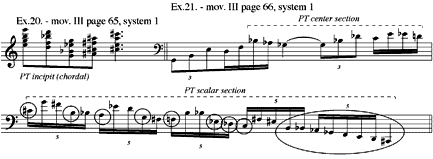Dr. Justin Henry Rubin: Thematic Metamorphosis and Perception in the Symphony [No. 1] for Organ of Kaikhosru Sorabji (5/7)

Ex.16. – mov. II, page 60, system 2; Ex.17. – mov. II, page 60, system 3
Ex.16. The PT incipit is dovetailed with the FS1/R. This cohesion is made more seamless through the adjustment of the note values into even eighths. It would seem that Sorabji chooses to modify either the rhythmic parameters if the interval/melodic contours remain for the most part unchanged, or vice versa. This allows the listener, by the end of the second movement, to clearly make substantial material connections with the ideas of the first movement. However, this transparency is only to become internalized, and made part of the overall fabric in the third movement.
Ex.17. The chromatic three note descent, rhythmically augmented and modified, becomes the terminal point to a descending pedal line unassociated with either the FS2/R or the PT. Sorabji had used a similar figure in the Introductio section (page 40, system 2) at the conclusion of a large descent as well.

Ex.18. – mov. III, page 63, system 1; Ex.19. – mov. III, page 64, system 3
Ex.18. The ascending diminished triad motive becomes the platform for an asymmetrical sequence of ornamented material. Of interesting note is the extension of the rising minor thirds beyond the initial triad itself.
Ex.19. The concept of sequencing a motive fragment in order to create a larger contoured construct is made manifest in this example. Notice that the steps within this pedal sequence of the PT incipit are irregular, encompassing a minor third, major third, major second, and perfect fourth.

Ex.20. – mov. III, page 65, system 1; Ex.21. – mov. III, page 66, system 1
Ex.20. Although not in any way obscured by the texture, the PT incipit here takes on an inverted function as a terminal motive, thus reversing the role that the listener has thus far perceived to be its nature.
Ex.21. As the fantasy continues, the motive fragments become more entwined with freely improvised material. In this pedal passage, the central portion of the PT emerges from previously unrelated ideas. As well, the scalar descent is braided within a two tiered contrapuntal line within itself.

Ex.21. – mov. III, page 66, system 3
Ex.22. Here again the ascending diminished triad is employed, this time not once but twice, in an anticipation of the PT, which itself is represented in a highly contracted and rhythmically altered form.
